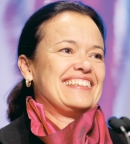In an updated analysis of the European phase III MINDACT trial reported in The Lancet Oncology, Martine Piccart, MD, and colleagues found confirmatory evidence of the initial finding of a high rate of distant metastasis–free survival among patients with high–clinical-risk but low–genomic-risk breast cancer who did not receive adjuvant chemotherapy. An exploratory analysis in such patients with hormone receptor–positive, HER2-negative disease suggested a chemotherapy benefit among patients aged 50 years and younger.

Martine Piccart, MD
Study Details
The trial enrolled a total of 6,693 patients with no distant metastases, with genomic risk measured using the MammaPrint 70-gene signature and clinical risk measured using a modified version of Adjuvant! Online. Patients with low clinical and low genomic risk did not receive chemotherapy, whereas those with high clinical and high genomic risk received chemotherapy. Patients with high clinical risk but low genomic risk and those with low clinical risk but high genomic risk were randomly assigned to receive chemotherapy or not based on either clinical risk or genomic risk.
The primary endpoint was to evaluate whether distant metastasis–free survival at 5 years in patients with high clinical risk and low genomic risk not receiving chemotherapy had a lower boundary of the 95% confidence interval (CI) above the predefined noninferiority boundary of 92%, with testing performed in the primary test population of such patients who adhered to the treatment allocation of no chemotherapy and had no change in risk post-enrollment (n = 644).
Adjuvant endocrine therapy was indicated for all patients with hormone receptor–positive tumors. Endocrine therapy was received by 77.3% of the entire study population and by 93.7% of the high–clinical-risk, low–genomic-risk group.
Key Findings
Median follow-up in the current analysis was 8.7 years (interquartile range = 7.8–9.7 years). The previously reported primary analysis of the trial showed 5-year distant metastasis–free survival of 94.7% (95% CI = 92.5%–96.2%) in patients with high clinical and low genomic risk who did not receive chemotherapy in the primary test population (n = 644). The updated 5-year distant metastasis–free survival rate among these patients was 95.1% (95% CI = 93.1%–96.6%), exceeding the predefined noninferiority boundary of 92% and supporting the previous analysis.
In the intention-to-treat population of 1,497 patients with high clinical and low genomic risk, 749 were randomly assigned to receive chemotherapy and 748 to no chemotherapy. Distant metastasis–free survival at 8 years was 92.0% (95% CI = 89.6%–93.8%) in the chemotherapy group vs 89.4% (95% CI = 86.8%–91.5%; absolute difference = 2.6%) for no chemotherapy (hazard ratio [HR] = 0.66, 95% CI = 0.48–0.92).
An exploratory analysis in the subset of 1,358 patients in the intention-to-treat population (90.7%) with hormone receptor–positive, HER2-negative disease showed differences in 8-year distant metastasis–free survival for receipt of chemotherapy (n = 676) vs no chemotherapy (n = 682) according to age. Rates at 8 years were 93.6% (95% CI = 89.3%–96.3%) with chemotherapy vs 88.6% (95% CI = 83.5%–92.3%) without chemotherapy among 464 women aged ≤ 50 years (absolute difference = 5.0%, standard error [SE] = 2.8, 95% CI = –0.5–10.4; adjusted HR = 0.54, 95% CI = 0.30–0.98) compared with 90.2% (95% CI = 86.8%–92.7%) vs 90.0% (95% CI = 86.6%–92.6%) among 894 women aged > 50 years (absolute difference = 0.2%, SE = 2.1, 95% CI = –4.0–4.4; adjusted HR = 0.82, 95% CI = 0.55–1.24). As noted by the investigators, adjuvant endocrine therapy in women aged ≤ 50 years consisted primarily of tamoxifen, with a luteinizing hormone–releasing hormone analog being used in only 21.3% of these patients.
With a more mature follow-up approaching 9 years, the 70-gene signature shows an intact ability of identifying among women with high clinical risk, a subgroup, namely patients with a low genomic risk, with an excellent distant metastasis–free survival when treated with endocrine therapy alone....— Martine Piccart, MD, and colleagues
Tweet this quote
An additional exploratory analysis in the 1,358 patients from the ITT population with HR-positive, HER2-negative disease suggested similar outcomes irrespective of nodal status. Distant metastasis–free survival at 8 years was 91.7% (95% CI = 88.1%–94.3%) with chemotherapy vs 89.2% (95% CI= 85.2%–92.2%) without chemotherapy among 699 node-negative patients (absolute difference = 2.5 percentage points, SE = 2.3, 95% CI = –2.1–7.2) and 91.2% (95% CI = 87.2%–94.0%) vs 89.9% (95% CI = 85.8%–92.8%) among 658 patients with one to three positive nodes (absolute difference = 1.3 percentage points, SE = 2.4, 95% CI = –3.5–6.1).
The investigators concluded, “With a more mature follow-up approaching 9 years, the 70-gene signature shows an intact ability of identifying among women with high clinical risk, a subgroup, namely patients with a low genomic risk, with an excellent distant metastasis–free survival when treated with endocrine therapy alone. For these women, the magnitude of the benefit from adding chemotherapy to endocrine therapy remains small (2.6 percentage points) and is not enhanced by nodal positivity. However, in an underpowered exploratory analysis this benefit appears to be age-dependent, as it is only seen in women younger than 50 years where it reaches a clinically relevant threshold of 5 percentage points. Although, possibly due to chemotherapy-induced ovarian function suppression, it should be part of informed, shared decision-making. Further study is needed in younger women, who might need reinforced endocrine therapy to forego chemotherapy.”
Dr. Piccart, of Institut Jules Bordet, Université Libre de Bruxelles, Brussels, is the corresponding author for The Lancet Oncology article.
Disclosure: The study was funded by the European Commission Sixth Framework Programme. For full disclosures of the study authors, visit thelancet.com.

